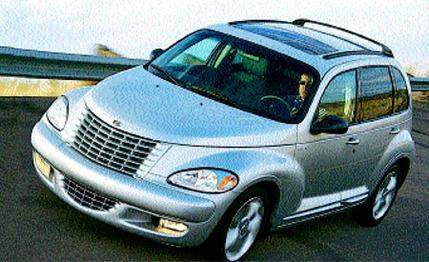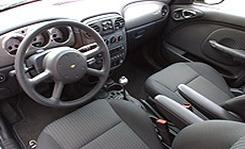 First Drive Review
First Drive Review
Okay, it had to happen. After teasing us with a cool concept version of the PT Cruiser--called the GT Cruiser--complete with a high-output engine and much sleeker styling, Chrysler has decided to take production Cruisers to a higher level.
This vehicle, the PT turbo, transfuses the PT Cruiser with more power. Using a Mitsubishi turbocharger to blow 14 pounds of boost down the 2.4-liter four-cylinder engine's throat, the bruiser Cruiser makes 205 horsepower at 5200 rpm. That's 55 more nags than the stock Cruiser has in the traces. The forced induction also adds torque--up to 240 pound-feet, if the engineers meet their targets. And that's 78 extra pounding little feet.
From what we've seen of the new car at Chrysler's desert proving ground in Wittman, Arizona, nearly all that torque arrives early for the party. When launched from a standing start, the PT Turbo spun its front wheels eagerly, even in automatic-transmission form, and it rushed off with an intensity not seen in normal Cruisers.
Larry Lyons, V-P of small-vehicle engineering, says the stick-shift PT Turbo will reach 60 mph in about 7.5 seconds (a second quicker than its unblown sibling) and in about eight seconds in automatic-transmission form. That autobox, incidentally, will feature the corporation's AutoStick manumatic for the first time in the PT Cruiser model range.
More power is a good thing. Now DaimlerChrysler just needs to figure out what it plans to call the car. The invitation to the unveiling called it the 2003 PT Cruiser GT, and sure enough, there were little GT badges on the first-level prototypes we drove. But company spokespersons now say the car should be called the PT Turbo. All right, whatever. Just let us know when you've made up your minds, okay?
Perhaps they're vacillating because one of the best features of the GT Cruiser show car was its revised styling, and we get almost nothing of that on this new turbo Cruiser. But there are several visible detail changes--some essential, some cosmetic.
The PT Turbo gets new front and rear fascias in body color, the front modification being necessary to package the turbo intercooler, which is under the engine radiator. It also gets 17-inch wheels, which look pretty bitchin' on the Cruiser, if we may be allowed to say so. The bumpers--otherwise unchanged--are body color, too.
Under the skin, there's a new iron engine block, new rods and crankshaft, and new pistons. The compression ratio has dropped to a low 8.1:1, and the exhaust-pipe diameter was widened by a half-inch. Chrysler adopts equal-length driveshafts on PT Turbos, using outrigger bearings, and we can report negligible torque steer during our short test drive at the desert proving ground.
The PT Turbo's five-speed manual transaxle is a Getrag unit like that found in the European-market turbo-diesel PT Cruiser, but it has ratios unique to this model. The four-speed Getrag automatic transmission is the same as in the turbo-diesel.

Inside the car there is a new slate-gray interior, unique seats with longer cushions and pronounced side bolsters, a dot-matrix instrument-panel surround, and a silver shift ball. Naturally, the famous PT Cruiser seating and cargo-carrying versatility (30 seat-position configurations) remains intact. Heated leather seats will be optional.
The aforementioned power and torque increases put the PT Cruiser in a different league, and to apply this newfound urge to the pavement properly, the PT Turbo has stiffer springs and retuned shocks. (The anti-roll bars are unchanged.) For improved grip and handling, the wheels will be shod with Goodyear Eagle RS-A P205/50HR-17 all-season performance tires, slowed by four-wheel disc brakes with ABS.
Our short drive revealed something other than just profoundly increased thrust. The PT Turbo feels good, with a firm ride and taut steering responses. So, for an anticipated $3000 premium over the base version, you can now look cool and kick butt, too. Hey, just another reason to get one.